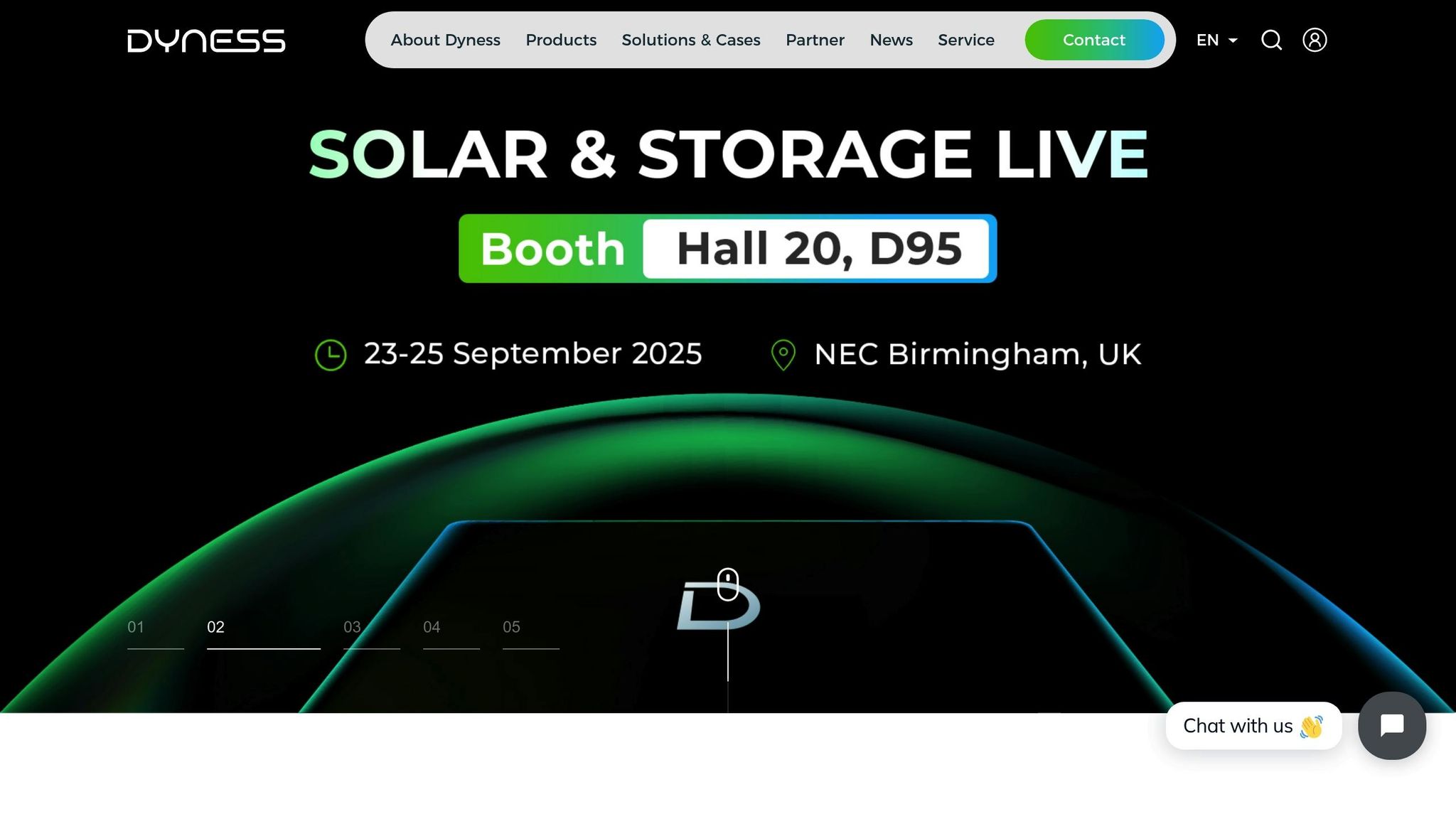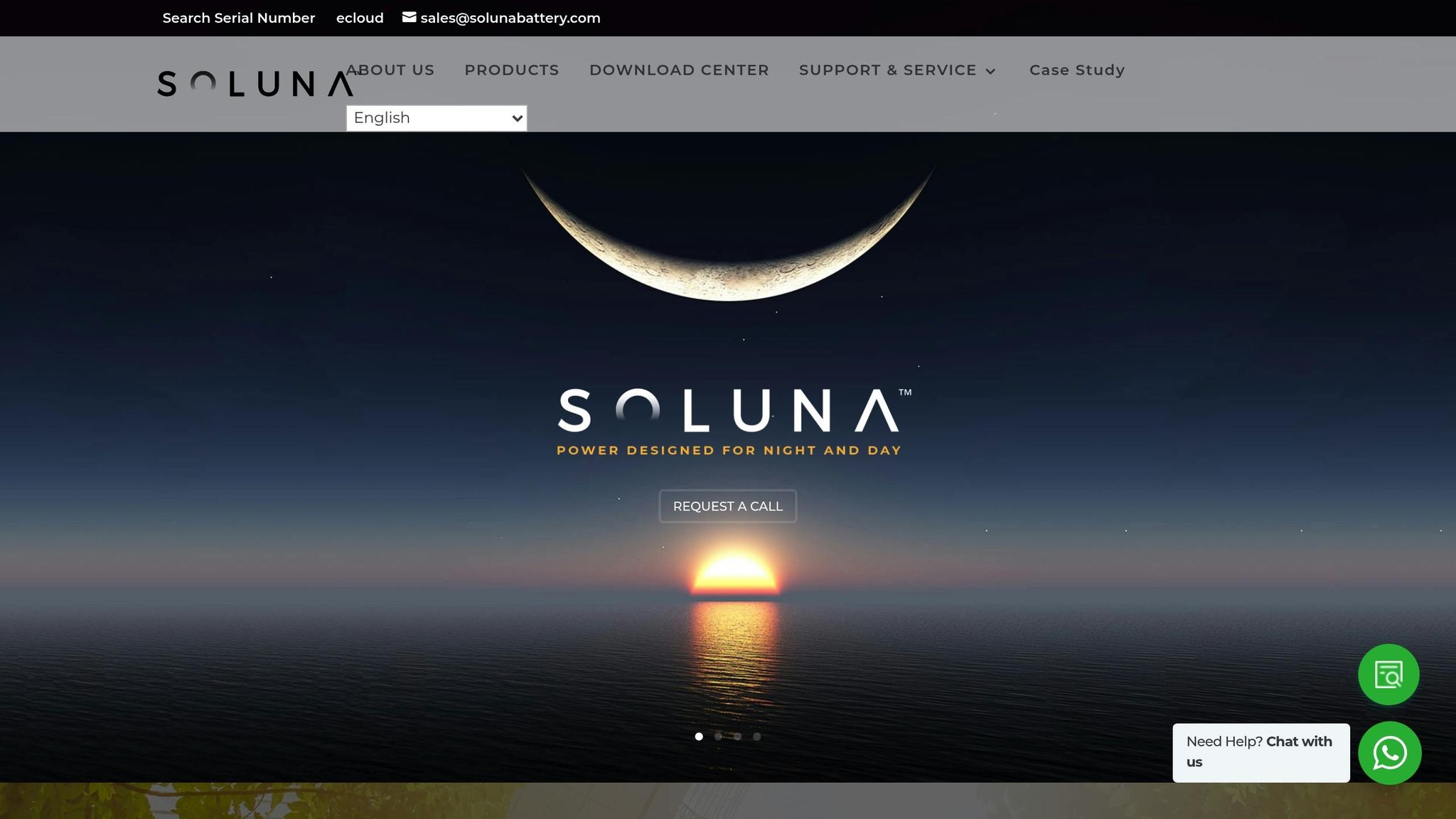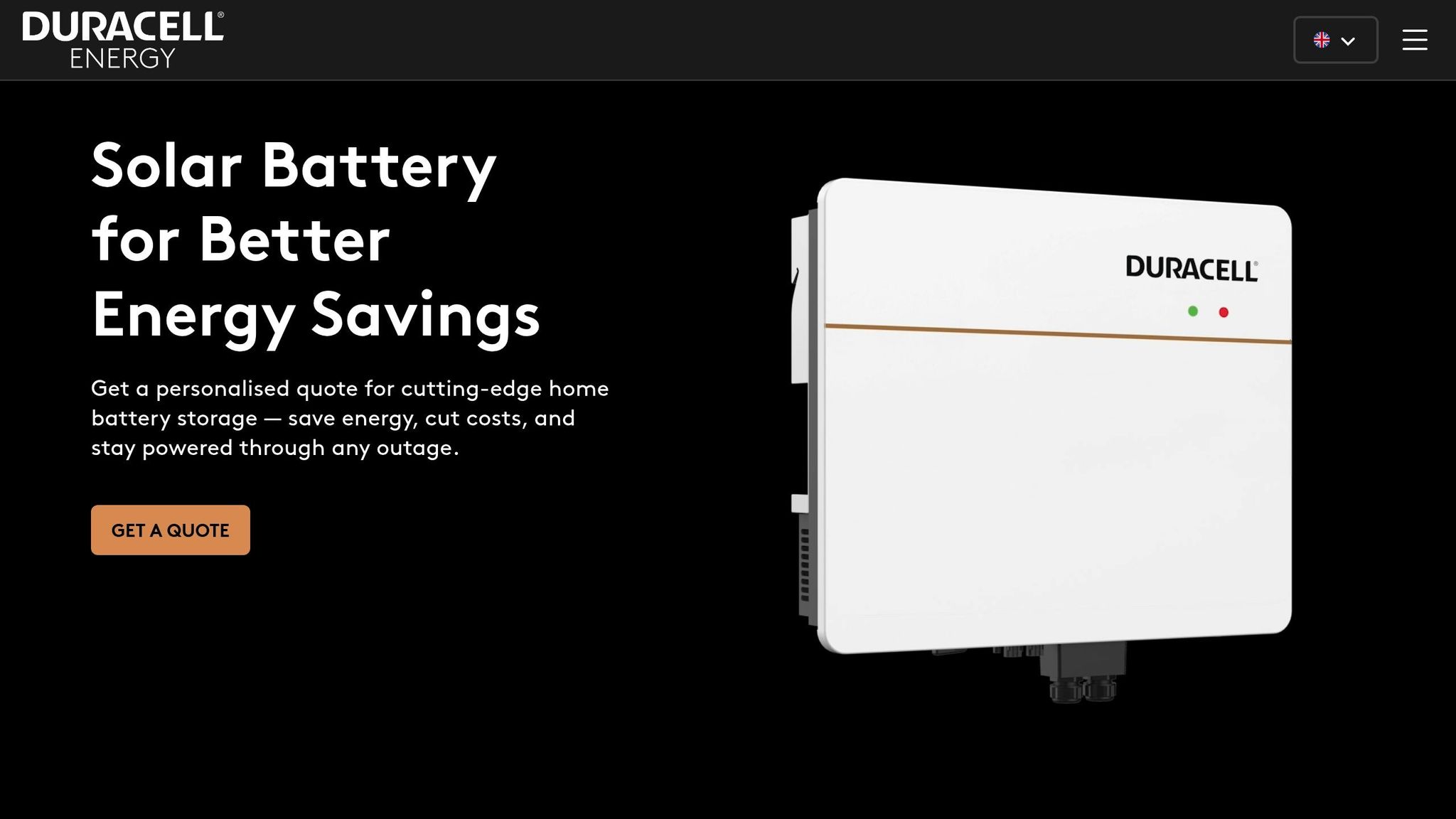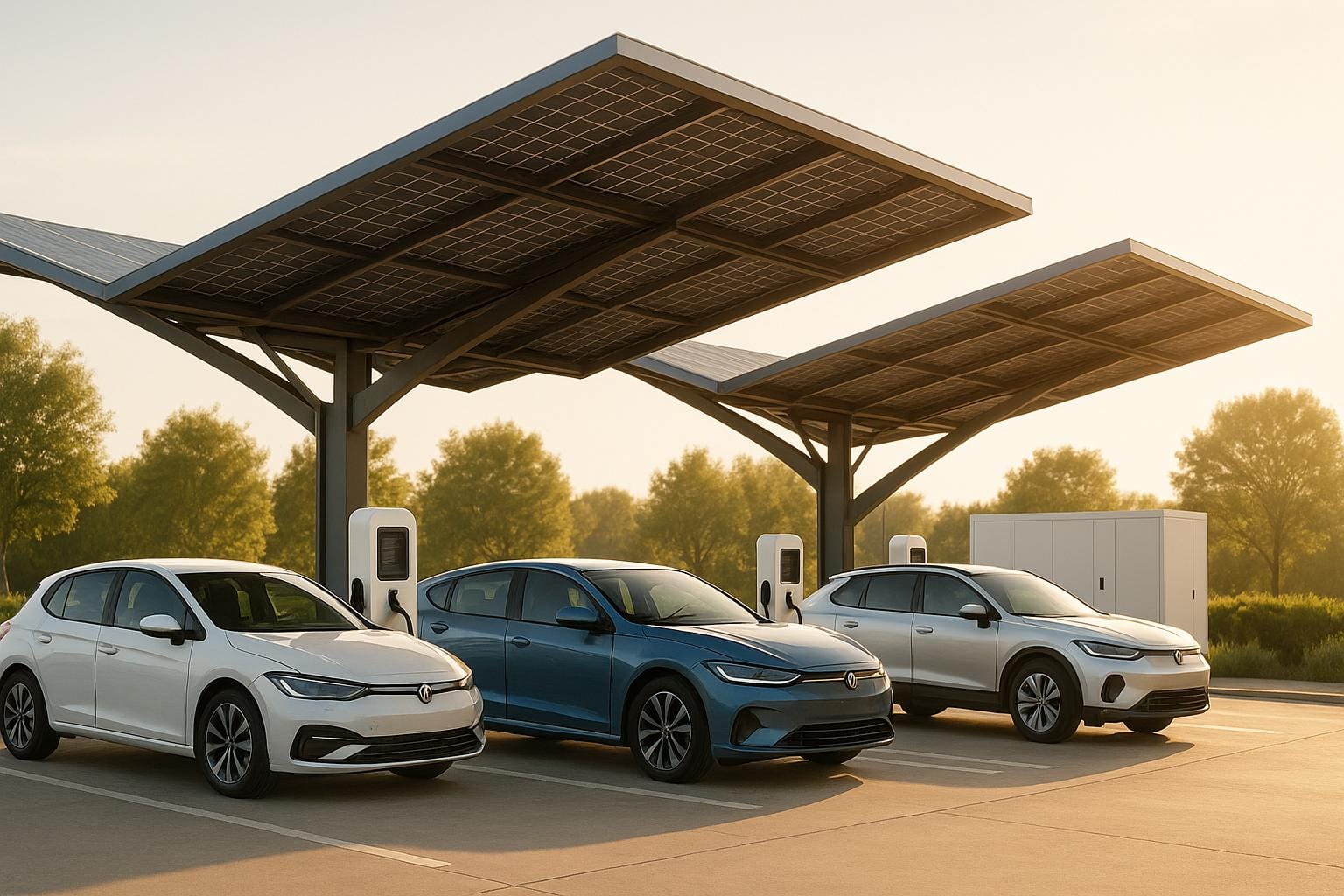When charging multiple EVs at home, solar energy combined with battery storage can cut costs and reduce grid reliance. In Northern Ireland, rising electricity prices and government incentives make this setup increasingly appealing. Choosing the right battery is crucial to ensure your household can meet daily energy needs efficiently.
Key Points:
- Daily Energy Needs: Two EVs can require 40–60kWh daily, depending on driving habits.
- Battery Options: Dyness (£2,400), Soluna (£3,000), and Duracell (£3,650) offer 10kWh capacity, with varying costs, features, and warranties.
- Savings Potential: Households can save £400–£600 annually on electricity by using stored solar energy during peak hours.
Quick Comparison:
| Feature | Dyness 10kWh | Soluna 10kWh | Duracell 10kWh |
|---|---|---|---|
| Price (£) | 2,400 | 3,000 | 3,650 |
| Efficiency | 95% | Not specified | 93% |
| Warranty | 10 years | Extended | 10 years |
| Key Benefit | Affordable | Smart grid | Professional installation |
For families with multiple EVs, the Dyness battery is the most cost-effective, Soluna balances cost and features, while Duracell offers added installation and support. Your choice depends on budget, energy needs, and desired level of support.
1. Dyness 10kWh Battery

For households with more than one electric vehicle (EV), having an efficient energy storage system is vital. The Dyness 10kWh lithium iron phosphate battery strikes a solid balance between performance and affordability, making it a smart choice for families with two EVs who need reliable energy storage without overspending.
Storage Capacity (kWh)
The Dyness battery provides a usable capacity of 9.6kWh out of its nominal 10kWh rating, which is enough to charge an EV for approximately 48–64 km of driving. For households with multiple EVs, this means it can partially charge both vehicles or fully charge one EV overnight while still topping up the other.
Its modular design offers the flexibility to expand storage up to 30kWh by adding more units. This scalability allows families to start with a single 10kWh battery and increase capacity as their energy needs grow, making it a future-proof solution.
Efficiency
With a 95% round-trip efficiency, the Dyness battery ensures that nearly all the solar energy it stores is available for use. Its intelligent battery management system (BMS) optimises charging cycles and prevents over-discharge, safeguarding the system’s long-term performance.
The battery is designed to handle Northern Ireland’s fluctuating weather, with temperature compensation features that ensure reliable operation in conditions ranging from chilly winter lows of 2°C to summer highs of 18°C.
Cost (£)
Priced at £2,400, the Dyness 10kWh battery offers excellent value for money. This works out to about £250 per kWh of storage, making it an affordable option for families who want dependable energy storage without overspending.
The system typically pays for itself in 7–9 years, thanks to reduced reliance on grid electricity. For families regularly charging two EVs, annual savings on peak-rate electricity can range from £400 to £600, depending on driving habits and charging schedules.
Warranty and Lifespan
The Dyness battery comes with a 10-year warranty, covering manufacturing faults and performance degradation. It’s designed to retain 80% of its capacity after 6,000 cycles, which translates to a lifespan of 15–20 years.
This longevity makes it a reliable option for families planning their energy needs over the long term. Even after the warranty period, the battery will still provide sufficient capacity for EV charging, ensuring consistent performance for years to come.
The warranty includes coverage for the battery cells, the management system, and key components like the inverter. For families investing in their home energy setup, this comprehensive protection offers valuable peace of mind. This detailed breakdown highlights how the Dyness battery measures up as a strong contender in the market for home energy storage solutions.
2. Soluna 10kWh Battery

The Soluna 10kWh Battery is tailored for households with multiple vehicles, offering 10kWh of usable energy storage that can handle both electric vehicle (EV) charging and general household energy needs. Built with lithium iron phosphate technology, this battery seamlessly splits its energy between charging EVs and powering domestic appliances, optimising your energy use.
One standout feature is its energy management system, which intelligently distributes stored solar energy based on your daily energy habits. It ensures EVs are prioritised for charging while still providing power for other household demands. This thoughtful design helps balance energy usage without sacrificing convenience.
The battery’s compact size makes it a practical choice for homes with limited space. Whether installed in a garage or utility room, it fits neatly without obstructing access to EV charging points. Plus, it’s designed to operate reliably across the UK’s varying temperatures, ensuring consistent performance year-round.
What sets the Soluna apart from models like Dyness is its focus on advanced grid integration and long-term reliability. It supports smart grid features, comes with an extended warranty, and is built for durability, making it a solid choice for households with increasing EV charging needs. This combination of advanced technology and long service life ensures it can keep up with your energy demands well into the future.
3. Duracell 10kWh Battery

If your household has multiple EVs, having reliable and efficient energy storage is a must. The Duracell 10kWh Battery is designed to meet those demands, offering a solid 10kWh capacity at a price of £3,650. This model is aimed at providing greater energy independence and high performance. With a round-trip efficiency of 93%, a 10-year warranty, and the ability to retain 80% of its capacity even after 6,000 cycles, it’s built to last and perform.
EECO Energy is an authorised installer of Duracell battery systems in Northern Ireland. They ensure the battery is seamlessly integrated with your solar panels and EV charging setup, making it a convenient choice for households looking to optimise their energy use.
sbb-itb-d2d975a
Comparison of Battery Storage Options
When choosing a battery storage system for your multi-car household’s solar EV charging setup, it’s essential to weigh both capacity and price. According to EECO Energy, these factors are key to finding the right fit. Here’s a quick look at how three popular 10kWh battery options compare in terms of cost and value:
| Feature | Dyness 10kWh | Soluna 10kWh | Duracell 10kWh |
|---|---|---|---|
| Capacity | 10kWh | 10kWh | 10kWh |
| Price | £2,400 | £3,000 | £3,650 |
The Dyness battery stands out as the most affordable choice at £2,400, offering reliable energy storage for households with multiple EVs. It’s a cost-effective way to meet your charging needs without stretching your budget.
The Soluna battery, priced at £3,000, provides a middle-ground solution. It balances performance and cost, making it a good option for families who need a dependable system for daily EV charging without opting for the highest-priced choice.
At the premium end, the Duracell battery comes in at £3,650. While it’s the most expensive, it includes installation by EECO Energy, ensuring smooth integration and professional support. For households in Northern Ireland, this option offers added reassurance through expert installation and ongoing maintenance, making it particularly appealing for more complex multi-car charging setups.
Choosing the right battery depends on your budget, energy needs, and the level of support you value for your system.
Conclusion
Selecting the right battery storage system comes down to finding the right balance between your budget, energy requirements, and long-term goals. Each option caters to the unique priorities of Northern Ireland households managing multiple EVs.
The Dyness battery is a solid choice for those looking for an affordable way to begin their solar-powered EV charging journey. It offers dependable energy storage without requiring a large upfront investment, making it a practical entry-level option.
The Soluna battery is tailored for households with moderate energy demands. It provides reliable daily charging for multiple vehicles while keeping costs manageable, making it a balanced option for many.
For those with more complex energy needs, the Duracell battery stands out as the premium solution. Ideal for households with multiple EVs, it comes with professional installation and ongoing support through EECO Energy, an approved Duracell installer. This ensures seamless integration with your existing energy setup and reliable performance over time.
While all three systems offer similar storage capacities, the added benefits of professional installation and long-term support – particularly with the Duracell system – can make a significant difference in overall performance and reliability. For households prioritising energy independence and efficient multi-car charging, these features may provide added value.
Ultimately, your decision should reflect your household’s specific charging habits, financial considerations, and dedication to long-term energy solutions for managing multiple EVs.
FAQs
What impact do the efficiencies of Dyness, Soluna, and Duracell batteries have on multi-car solar EV charging systems?
The efficiency of a battery plays a crucial role in the performance of a multi-car solar EV charging system. It directly impacts energy losses during charging and discharging. Dyness batteries, boasting an efficiency of over 95%, are excellent at reducing energy waste. This means more cost-effective operation and improved charging performance for multiple vehicles.
On the other hand, Duracell batteries stand out for their rapid charge and discharge capabilities, along with capacities reaching up to 80 kWh. These features make them a reliable option, especially for households managing several EVs.
While detailed efficiency data for Soluna batteries may not be as accessible, incorporating high-efficiency batteries like Dyness and Duracell into your system ensures maximum energy usage, minimal losses, and an overall boost in performance. Selecting the right battery setup is key to achieving smoother operation and greater energy independence for multi-car households.
What should I consider when choosing between Dyness, Soluna, and Duracell batteries for my solar EV charging system?
When choosing between Dyness, Soluna, and Duracell batteries, it’s essential to think about your household’s energy requirements, budget, and how well the battery integrates with your existing system. Key things to look at include battery capacity, which tells you how much energy can be stored, and lifespan, which influences long-term cost-effectiveness. You’ll also want to check the efficiency and charge/discharge rates, as these determine how well the battery can store and deliver energy when needed.
Dyness batteries stand out for their durability and adaptability, making them a solid pick for off-grid setups or areas where the grid is less reliable. Soluna focuses on compact and efficient designs, while Duracell offers lithium iron phosphate (LiFePO4) batteries, which are versatile and typically come with capacities around 5 kWh – suitable for a variety of household sizes. To pick the right battery for your multi-car solar EV charging system, consider your daily energy consumption, peak power needs, and the space you have available.
What are the long-term advantages of adding a battery storage system to your solar EV charging setup in Northern Ireland?
Investing in a battery storage system for your solar EV charging setup can bring a host of long-term advantages. By storing surplus solar energy, you can rely less on the grid, giving you more control over your energy use. This means you’ll have power available for your home and electric vehicle, even on cloudy days or during power cuts.
Another benefit is the potential to cut energy costs. A battery system lets you store electricity during off-peak times, when rates are lower, so you can use it during peak periods when prices rise. Over time, this can make a noticeable difference to your electricity bills. Plus, by using your stored solar energy, you’re making the most of renewable power, which supports a greener and more eco-conscious way of living.
For households in Northern Ireland, where energy prices can be unpredictable, a battery storage system offers a sensible way to save money while lowering your carbon footprint.


